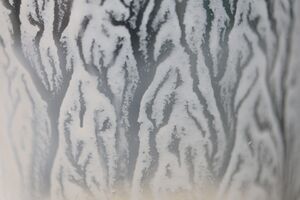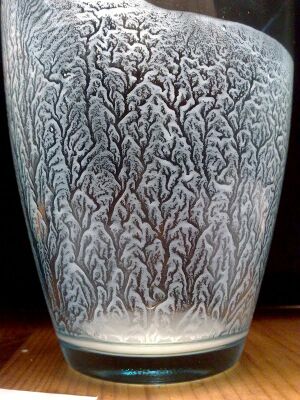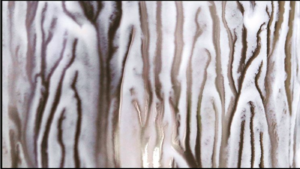First draft chapter one
First draft outline chapter 1 Tessel Schmidt
Chapter 1
Before entering the Piet Zwart Institute I made a work filmed in the carwash. The chosen frame and perspective create a new world within the frame. I also experimented with filming shadowflicker on my walls at home caused by the blades of a typical Dutch windmill in my garden. I have been working on a treatment in which I tried to unite the images of the shadows with stories of people who suffer from shadowflicker in their homes. I have not finished this work yet. During my first year at Piet Zwart I bought a macro lens to get even closer to my subjects and made some experiments with it. I made a video work with buttermilk dripping down a surface creating an image that brings the viewer to a secluded place in the snow. With this work I also experimented with sound. I started with adding music, but that made the work too bombastic. I searched for sounds of ice, melting ice and ice floes and edited it in the film. That worked out very well. Especially when the video was shown in the Eye museum on the big screen. I also filmed bath foam with my macro lens. I love the structure of the foam and it’s popping and often assembling bubbles. I put my camera in front of a small amount of foam and kept filming to see what happens. In the first video the auto focus was on so the camera starts later on focusing on the curtains. A surprising moment! I wrote a text about this video from the point of view of my camers: Me, the camera In the second video (screenshots) I made a set with very small bubbles who in 30 minutes start sticking together more and more and becoming bigger bubbles. At the end you see the wonderful structure of the bubbles. This work is still in progress. • Bubble Landscape 1 • Bubble Landscape 2 • Bubble Landscape 3 Last year I was as a videographer involved in a theatre project with refugees who live in my neighborhood. I started to interview them and tried to catch their emotions around the trapped situation they are in without filming their faces directly. I filmed with my macro lens very close to the skin (Samson’s hand) and in the edit experimented with more screens (triptych) in one frame. I used their voices as a voice over. This led to a series of very short clips. In the summer of 2020 I did a testshoot with fisherman. I filmed the fisherman waiting to catch a fish and catching a fish. I am now working on a proposal for the municipality of Utrecht to get the project commissioned. Another attempt to express a feeling of a situation (being in lockdown with my son at home) in a video work is Kid. I made close images of my son’s toys (toys that have movement) and mixed the images and original sounds in a triptych projected on cloth diapers hanging the wall. Video Kid1 is what the viewer would see in a exhibition. Video Kid2 is the images that is being projected. I tried to explore this way of working already a little bit with the clips I made with refugees, especially because I was not allowed to film their faces. The challenge is to look for images that complement the stories and express the emotions from the stories. A few weeks ago I visited refugee Samson at his room in the refugee hoe (AZC). I shot small videos of details in his room and recorded our conversation. Samson also started to read out loud the cards he received during his period in prison (when there was no other place for him to stay). I made 4 edits. The first edit is the voice over of Samson and images of details in his room (still rough edit). The other 3 video's are an edit from what I think is the best shot I made there combined with 3 different soundscapes. I must say that my experience was not so pleasant at the refugee home. I wrote a text about it in Dutch. Her you can find the text: Dear Samson I decided not to go on with depicting the stories of refugees for my final project because I needed more time to get my intentions right because the topic is very fragile. On my wiki I uploaded some new experiments I shot with Samson at the refugee home were he lives. So distilling the elements from my previous work into a few words it would be: Neighborhood, macro images, people’s story’s, emotions, new landscapes, importance of the still frame, let it happen inside the frame, expressing a feeling of a situation, triptych, making a set-up with a material.
Most important work: Buttermilk work What have I made; how did I make it and why did I make it.
Text about what my camera sees https://pzwiki.wdka.nl/mediadesign/Me,_the_camera
Skaftafall (2021)
Pre production
Inspiration During the lockdown in 2021 I was sitting on the sofa and dreaming away a bit. I saw an empty glass of buttermilk next to me. I was immediately drawn to the buttermilk cracks that were formed on the glass.
I started to do some tests with filming buttermilk in a glass. I put a glass on the ground, used my petrol-colored curtains as a background and poured some buttermilk along the edge of the glass. I also put my camera on the floor with the macro lens on it. I let the camera run for as long as the buttermilk was still moving. It took 5 minutes. This is an image from that first shoot:
Set-up and materials (insert photographs of work process)
After doing some test I made a bigger set-up with a bigger glass and more buttermilk. I made the set-up in the kitchen. Making use of the light from the windows. I put the camera on a tripod and kept it there.
Production
Camerawork
Framing: Still image, one frame no movement. The movement comes from the uttermilk.
Perspective: eye height
Audio Audio from
Light
Post production-editing
Materials Mostly waterrelated fluids



